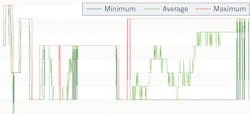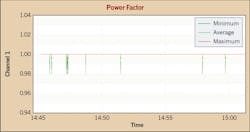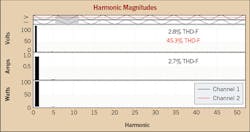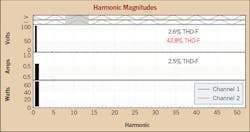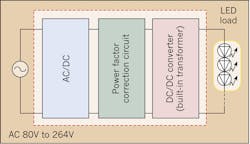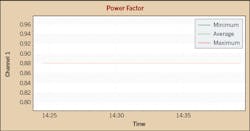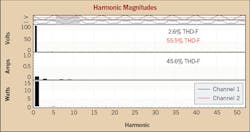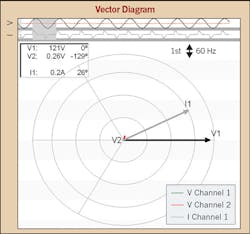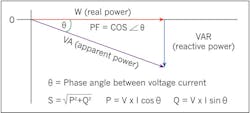Low-Energy Lighting and Power Quality
Compact fluorescent lamps (CFLs) and some light-emitting diodes (LEDs) present a much greater non-linear load on the distribution system compared to incandescent lights. As the less energy-efficient incandescent lamps continue to be phased out and replaced with new low-energy lighting options, this sometimes comes at the cost of power quality.
Incandescent lamps provide an almost ideal resistive load at power line frequencies. A load that is totally resistive, with no reactance, results in a power factor of 1.0. This is an ideal condition, allowing all current supplied by the distribution system to be consumed as real power by the lamp. For the purpose of taking control data, a standard 100W incandescent lamp was used. Measurements were made using a receptacle-type power quality recorder. The two power quality measurements investigated were the total harmonic distortion (THD) and true power factor. The THD quantifies the amount of current harmonic distortion introduced into the distribution system, while the true power factor is a measure of the overall power delivery efficiency (including reactive and harmonic effects).
For reference, the incandescent lamp tested actually consumed 102W (Fig. 1). Graphs of power factor and harmonic magnitude with incandescent lamps are included as a control or reference to compare to low-energy lighting (Fig. 2). A resistive load will add very little harmonic distortion to the voltage waveform — any current distortion from the lamp is a reflection of the incoming voltage distortion.
Halogen lamps are good replacements for standard incandescent lamps. Fundamentally, a halogen lamp is also a resistive load — it’s a glowing filament like a traditional incandescent. On average, they consume 28% less energy compared to an incandescent bulb for the same light output. These lamps also have a power factor of almost 1.0.
Halogen lamps are sometimes called quartz-halogen, quartz iodine, or tungsten halogen lamps. They are, by definition, an incandescent lamp that has a tungsten filament enclosed in halogen gas. When energized, a chemical reaction takes place that redeposits the evaporated tungsten onto the filaments. This chemical process increases the life of the lamp and allows the envelope to remain crystal clear for long periods of time. Due to their unique properties, halogens operate at a higher color temperature than standard incandescents and generate a higher luminous level using the same or less power input than a standard incandescent lamp. Because they are for all practical purposes a highly efficient incandescent lamp with a resistive tungsten element, they present a resistive and not reactive load at power line frequencies. This property allows for the same ideal power factor and low harmonic distortion as an incandescent lamp, with increased efficiency (in terms of light output per watt), as shown in Fig. 3.
CFLs are the worst offenders to power quality compared to halogen, LED, and electron stimulated luminescence (ESL) lighting with a typical power factor of around 0.5 to 0.7, as shown in Fig. 4.
CFLs are very energy efficient, producing much more light with less power consumed. Featuring the advantage of having a longer life than incandescent lamps, they consume, on average, 75% less energy than the standard incandescent lamp for the same light output.
LEDs are diodes, and diodes are very nonlinear devices. LEDs are low-voltage devices, and cannot operate directly from a 120V AC source. LEDs include a power supply that rectifies the AC to DC, and includes some type of voltage or current regulation. To maintain a high efficiency and small size, this power supply is typically an electronic switch mode power supply.
Many trade-offs are involved in designing a mass-produced, small, efficient, but low-cost LED power supply. A good design can include power factor correction, harmonic filtering, radio frequency interference (RFI) filtering, and resistance to voltage sags. A poor design may have little or no thought put toward these issues. The result can be high harmonics (leading to a high true power factor, even if the 60-Hz power factor is still OK), RFI (leading to customer complaints to the electric utility about power line noise), and sensitivity to voltage flicker.
Several companies building LED power supplies are beginning to realize the importance of power quality and are including a power factor correction circuit in their design. A block diagram of one such power supply is shown in Fig. 5. The manufacturer claims an outstanding true power factor of 0.99 while maintaining a high efficiency of 83% (measurement of 0.88 shown in Fig. 6). This type of improved LED driver technology allows high-efficiency lighting to comply with IEC 61000-3-2, an international standard on harmonic current limits. It ensures a more linear load, allowing the power factor to be close to 1.00 and harmonics to be low (Fig. 7).
ESL lighting technology is a new use of an older idea. The ESL lamp works on the same principle as the old cathode ray tube in a television. An electron gun fires a spray of electrons at a phosphor coating on the inside of the lamp. The efficiency is comparable to that of a CFL, using about 70% less power than incandescent lamps. The power factor of an ESL lamp is around 0.99, which makes it close to being a purely resistive load. At this time, LEDs beat them on efficiency by around 10% while maintaining a lower cost. Many consumers do not know about power factor and buy solely on price/efficiency, so, in this case LEDs win. One advantage ESL has over CFL is that it can be used with a light dimmer.
As described in the PMI white paper, “Understanding How Harmonics Affect Power Factor,” true power factor can be reduced by the presence of harmonics or a reactive load. Either increases the RMS current (and thus the apparent power) without a corresponding increase in real power. Since the distribution system is burdened by the apparent power value, it is important to not only have a load that is efficient but also not reactive or rich in harmonics. An example of the reactance of a CFL putting the voltage and current out of phase is shown in Fig. 8.
At the present time, there are several low-energy lighting options available in the market to replace incandescent lamps. LEDs are the most efficient, closely followed by the CFL, ESL, and the halogen styles. The LED, if designed properly with power factor correction circuitry, can be 80% more efficient than a 100W incandescent lamp — and with a power factor as good as 0.99. The LED in these tests consumed about 14W and had a power factor of 0.88 with a lumens output of more than 1,600. This would make this LED 86% more efficient than an equivalent incandescent lamp. The CFL tested consumed 23W with a power factor of 0.64 and an output of 1,600 lumens. The CFL tested was 77% more efficient than the incandescent lamp. The halogen bulb consumed 72W with a power factor of around 1.00 and a lumen output of 1,200; it was 29% more efficient than the incandescent lamp.
For power generation and distribution, the amount of harmonic distortion and apparent power is of most importance. With higher volumes of CFLs introduced to replace the incandescent lamps, even with the offset of the higher efficiency, the far-from-perfect power factor and THD of CFLs could be problematic. Even with today’s LEDs — and a slightly better efficiency and power factor than with the older CFL lighting — the higher THD that they create can degrade power quality, causing issues to crop up that will need to be dealt with. Overall load from lighting may be smaller as these high efficiency bulbs are employed, but harmonic currents in an absolute sense are likely to increase, since traditional incandescents produced almost no harmonics. Technology that causes these problems can also be used to solve power quality issues. As high-efficiency lighting continues to evolve, power factor correction and harmonic filtering in each bulb may become more practical, and power quality may soon have a brighter future.
Real vs. Reactive Power
Real power is the power that is being delivered to the load to perform work. Reactive power results from a net impedance of the load being either inductive or capacitive, resulting in stored energy either in a magnetic field of the inductance or electrostatic field in the dielectric of the capacitance that cannot perform work over a 60-Hz cycle. This reactive power, sometimes called “wattless power,” increases the RMS current that must be delivered through the distribution system, but performs no work. An example of the relationship between apparent, real, and reactive power is shown in the Figure.
Andrus III is an electrical engineer - communications specialist for Power Monitors, Inc. in Mt. Crawford, Va. He can be reached at [email protected].
